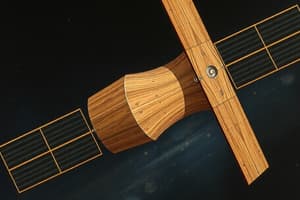Podcast
Questions and Answers
Первым человеком, отправившимся в космос на корабле 'Восток 1', был Юрий Алексеевич Гагарин.
Первым человеком, отправившимся в космос на корабле 'Восток 1', был Юрий Алексеевич Гагарин.
True (A)
Программа 'Gemini' была запущена Национальным управлением по аэронавтике и исследованию космического пространства (NASA).
Программа 'Gemini' была запущена Национальным управлением по аэронавтике и исследованию космического пространства (NASA).
True (A)
Космический корабль 'Союз' был разработан США.
Космический корабль 'Союз' был разработан США.
False (B)
Модернизированные космические корабли включают в себя модуль гидравлики.
Модернизированные космические корабли включают в себя модуль гидравлики.
Миссия 'Аполлон' закончилась высадкой на Марсе в 1969 году.
Миссия 'Аполлон' закончилась высадкой на Марсе в 1969 году.
Каждый модуль космического корабля имеет уникальную цель и разработан, чтобы выдерживать суровые условия космических путешествий.
Каждый модуль космического корабля имеет уникальную цель и разработан, чтобы выдерживать суровые условия космических путешествий.
Системы жизнеобеспечения не являются важными для выживания космонавтов во время миссии.
Системы жизнеобеспечения не являются важными для выживания космонавтов во время миссии.
Ракетные двигатели на твердом топливе могут обеспечивать более высокую пиковую тягу, чем двигатели на жидком топливе.
Ракетные двигатели на твердом топливе могут обеспечивать более высокую пиковую тягу, чем двигатели на жидком топливе.
Космические полёты стали более доступными благодаря разработке многоразовых космических кораблей, таких как Dрагон от SpaceX.
Космические полёты стали более доступными благодаря разработке многоразовых космических кораблей, таких как Dрагон от SpaceX.
Разработка коммерческих космических путешествий не повлияет на дальнейшее развитие технологий космических кораблей.
Разработка коммерческих космических путешествий не повлияет на дальнейшее развитие технологий космических кораблей.
Study Notes
Introduction
Since humans started exploring beyond our planet Earth, we have seen numerous advancements in cosmonautics. One of the most significant aspects of cosmonautics is the development of spacecraft, which allows us to transport astronauts and cargo to different destinations in space. In this article, we will dive deeper into the topic of spacecraft, discussing their designs, functions, and evolution throughout history.
Historical Background
The history of spacecraft can be traced back to the mid-20th century when the former Soviet Union launched the Sputnik satellite, marking the beginning of the space age. The first manned spacecraft, Vostok, was developed by the Soviet Union under the leadership of Sergei Korolyov to carry the first human into space. Yuri Gagarin became the first astronaut to orbit Earth aboard Vostok 1 on April 12, 1961.
In the United States, NASA's Gemini program followed, leading to the successful launch of the Apollo program, culminating in the historic moon landing on July 20, 1969. These spacecraft were designed to test various systems, including life support, navigation, and communication, while providing valuable data on how astronauts adapt to extended space missions.
Design and Functionality
Modules
Modern spacecraft consist of several interconnected modules, such as the pressurized habitation module, the avionics module, and the propulsion module. Each module serves a unique purpose and is designed to withstand the harsh conditions of space travel.
Propulsion Systems
Propulsion systems play a crucial role in maintaining an orbit or navigating through space. They use either liquid propellants or solid rockets. Liquid engines require precise control systems and can provide better thrust efficiency, while solid rockets can generate higher peak acceleration but have limited thrust control.
Life Support Systems
Life support systems are essential for keeping astronauts alive during their mission. These systems include air purification, water recycling, temperature regulation, and waste management. Advanced regenerative technologies minimize the need for expendable resources to ensure the crew's survival.
Evolution and Future Developments
Over the years, spacecraft designs have evolved significantly, incorporating new materials, advanced propulsion techniques, and improved life support systems. NASA is currently focusing on developing reusable spacecraft, such as SpaceX's Dragon, to reduce costs and increase accessibility to space travel. Additionally, the development of commercial space travel may lead to further advancements in spacecraft technology, opening up opportunities for scientific research and exploration beyond Earth.
In conclusion, cosmonautics has come a long way since its inception, with significant progress in spacecraft design and functionality. As we look forward to the future, we can expect even more innovative developments that will enable us to explore space and push the boundaries of human capabilities.
Studying That Suits You
Use AI to generate personalized quizzes and flashcards to suit your learning preferences.
Description
Test your knowledge on spacecraft designs, functions, and historical evolution with this quiz. Explore topics such as modules, propulsion systems, life support, and future developments in cosmonautics.





